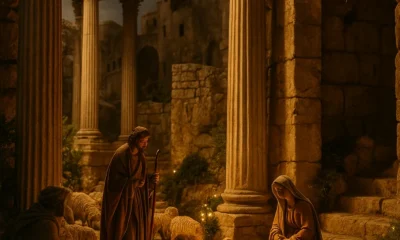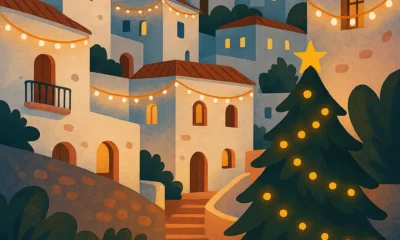Towns & Villages
Abla Guide. Discover Abla, Almeria — History, Nature, and Local Festivals
Published October 16, 2025 | Category: Towns & Villages
TL;DR: Abla is a charming mountain village at the foot of the Sierra Nevada, known for its Roman heritage, traditional festivals, local crafts, and peaceful rural lifestyle. Ideal for nature lovers, hikers, and those seeking authentic Andalusian life.
Discover Abla, Almeria — History, Nature, and Local Festivals
Set on the southern slopes of the Sierra Nevada, Abla is one of Almeria’s most historic and tranquil mountain villages. With cobblestone streets, whitewashed houses, and friendly locals, it offers a glimpse of authentic Andalusian village life far from the crowded coast. The town has deep roots that reach back to Roman times — historians identify it with the ancient settlement of Abula.
Today, Abla blends its agricultural heritage with a growing interest in rural tourism, hiking, and cultural activities promoted by the Ayuntamiento de Abla and the Junta de Andalucía.
Geography and Setting
Abla occupies an area of around 46 square kilometres and lies in the northwestern part of Almeria province, on the southern slopes of the Sierra Nevada, facing the Sierra de los Filabres. The village overlooks the upper course of the Nacimiento River, making it the natural gateway to the Alpujarra of Almeria. The surrounding landscape alternates between fertile valleys and gentle elevations such as “Cerrón de Guzmán” and “Loma de las Bazanas”, offering wide views over the mountains and olive groves.
Although its economy has traditionally been based on agriculture and livestock, Abla once hosted small industries such as distilleries, flour mills, and the production of olive oil, wine, cereals, and legumes. These activities, together with the breeding of wool cattle, sustained the village for generations. Today, rural tourism and traditional crafts continue that legacy, providing a small but steady source of local income.
Historical Highlights
Abla’s origins reach deep into antiquity. Many historians identify the modern village with the Roman settlement of Abula, mentioned by the geographer Ptolemy in his Geographia (Book II, 6, 60) as part of the Iberian region of Bastetania. Some scholars, however, propose that the reference might correspond instead to Ávila (ancient Obila), though Abla remains the most widely accepted identification among historians of Roman Hispania.
The municipality successively hosted Romans, Visigoths, and Muslims, each leaving their mark on its architecture and culture. The ruins of an Arab castle and the 2nd-century Roman mausoleum still bear witness to these layers of history. During the 15th century, conflicts between Christians and Moors led to a decline in population, but by the early modern period Abla had re-established itself as one of the first Christianized towns in southern Spain — a status that local tradition dates to the 1st century AD.
Visitors can still explore both the Arab castle remains and the Roman Mausoleum on the outskirts, along with the 16th- and 17th-century religious buildings that give the village its architectural charm. The parish church of La Anunciación, built in 1530, dominates the Plaza Mayor and remains a focal point for community life.
According to the Andalucía tourism portal, Abla also played a role during the Arab period, forming part of the Alpujarra route that connected Granada with the Mediterranean coast.
What to See and Do
- Mirador del Calvario: A panoramic viewpoint offering spectacular views of the Filabres mountains and the valley below — especially beautiful at sunset.
- Old Quarter Walk: Explore Abla’s narrow streets, whitewashed houses, and traditional courtyards filled with potted flowers.
- Local Crafts: The town is known for its traditional blacksmithing, basket weaving, and textile work, still visible in family workshops.
- Nature Trails: Several marked routes lead into the Sierra Nevada foothills. The “Ruta del Calvario” and the “Jairola Trail” are among the most popular. Maps are available at the Town Hall.
Local Festivals and Traditions
Abla celebrates several lively local festivals throughout the year, blending faith, music, and community. The best-known are the Fiestas de los Santos Mártires (Patron Saints’ Festival), held every April with processions, floral offerings, and open-air concerts. Summer brings the Fiestas de Verano, featuring music, dancing, and sports in the Parque Municipal. Both events attract visitors from nearby villages and returnees from abroad.
The official local holidays for 2025 are 28 April and 4 August, as recorded by the Junta de Andalucía’s provincial calendar. These dates correspond with Abla’s main celebrations and are great opportunities to experience village life up close.
Gastronomy
Abla’s gastronomy captures the essence of rural Almeria — simple, seasonal, and deeply rooted in tradition. The town’s cuisine shares much with the nearby Alpujarra region, featuring hearty mountain dishes prepared with local olive oil and fresh produce from the Nacimiento valley.
Signature recipes include migas almerienses (fried breadcrumbs with peppers and sausage), choto al ajillo (young goat cooked in garlic sauce), and comforting stews flavoured with local pimentón. Visitors will also find a variety of homemade sausages, mountain-cured hams, and almond-based sweets, all served in family-run restaurants and bars around the Plaza Mayor.
Getting There and Staying
Abla lies just off the A-92 motorway, about 55 km from Almeria city. The drive takes around 45 minutes, making it an ideal destination for a day trip or a peaceful rural stay. While accommodation options are limited, nearby towns such as Fiñana and Gérgal offer small guesthouses and rural homes.
Public transport is available via regional buses connecting Abla to Almeria, Guadix, and Granada, though schedules are limited. Travellers are advised to check timetables in advance via the Transport Consortium of Almeria.
Practical Information – Abla
- Town Hall (Ayuntamiento de Abla): Plaza Mayor, 1 — 📞 950 35 80 01 — www.abla.es
- Civil Guard (Guardia Civil): Ctra. Nacional 340, Km 385 — 📞 950 35 80 12
- Health Centre: Calle del Doctor Pérez, 10 — 📞 950 35 83 04
- Tourist Information: Inside Town Hall — open weekday mornings
- Emergency Numbers: 112 (General), 061 (Medical), 062 (Guardia Civil), 091 (National Police)
For more nearby destinations, visit our Towns & Villages category and explore the hidden gems of inland Almeria.
For local updates and community events, check our Community section.
Towns & Villages
Vera Nativity Scene 2025: A Monumental Journey to Ancient Rome
Published December 2, 2025 | Category: Towns & Villages
TL;DR: Vera has inaugurated its Monumental Nativity Scene 2025 at the Convent of La Victoria, offering a detailed artistic journey through ancient Rome and the historical context of the birth of Jesus, complete with handcrafted scenes, immersive design and a strong cultural message for the Christmas season.
Vera Unveils Its Monumental Nativity Scene, Transporting Visitors to Ancient Rome
The Christmas season has officially begun in Vera with the inauguration of its Vera Nativity Scene 2025, a cultural tradition that attracts residents and visitors from across the region. Set inside the Convent of La Victoria, this year’s Nativity Scene offers a striking and immersive journey to ancient Rome, recreating the atmosphere of the early Imperial era during the reign of Emperor Augustus—historically linked to the birth of Jesus.
The opening ceremony was enriched by the music of the Da Music Quartet and presided over by renowned Nativity scene artist Antonio de Haro Marquez. Widely respected for his artistry, dedication to the craft and contribution to cultural heritage, he recently received the Spanish Federation of Nativity Scene Makers Trophy at the 61st National Nativity Scene Congress. He was joined by the Mayor of Vera, Alfonso Garcia Ramos, and the Councilor for Culture and Heritage, Antonio Jesus Soler Castano, who highlighted the importance of this tradition for the cultural identity of the municipality.
The construction of this year’s Nativity Scene has once again relied on the collaboration of the “Friends of the Vera Nativity Scene” Association, with lighting and 3D effects designed by Francis Sanchez Morata. According to the Ayuntamiento de Vera, the 2025 edition continues the town’s commitment to preserving a tradition deeply rooted in local heritage while also offering an evolving artistic experience each Christmas season.
A Journey Into Ancient Rome
The Monumental Nativity Scene 2025 stands out for its detailed reconstruction of ancient Rome. Visitors enter a visual narrative where elements of imperial grandeur coexist with everyday life and the humble origins of Christianity. Towering columns, lush gardens, stone pathways and architectural motifs recreate the setting of the Roman Empire in full splendor. These scenes contrast sharply with the modest depiction of the birth of Jesus, underscoring the difference between imperial power and the simplicity of the Holy Family.
The design intentionally alternates between moments of political power and scenes of ordinary life. Shepherds, craftsmen and families appear alongside ruins, market squares and symbolic landscapes. At the center of the display stands a cascading waterfall, symbolizing purity, renewal and the strength of life even in difficult times. Every corner reveals handcrafted figures, intricate textures and small details that invite visitors to pause, observe and reflect. As one of the most visited Vera Nativity Scene exhibitions in recent years, it continues to blend artistic creativity with cultural heritage.
Among the most striking scenes is the depiction of the Massacre of the Innocents, where Herod is presented as a ruler whose fear manifests in violence. This dramatic scene contrasts with quieter spaces that show daily Roman life, creating a rhythm that blends storytelling, history and devotion.
An Artistic, Cultural and Spiritual Dialogue
During the inauguration, Antonio de Haro Marquez described the Nativity Scene as more than a display. To him, it is a creative and emotional journey that invites visitors to reconnect with values of humility, hope and renewal. He explained that the experience is not only artistic but also reflective, offering people a way to understand and appreciate a moment in history that continues to shape cultural and spiritual traditions.
His words resonated with the audience, particularly when he reflected on how each corner of the Nativity Scene carries a message. Some scenes invite contemplation, others narrate familiar biblical events, and many encourage visitors to share stories, emotions and curiosity with children—keeping traditions alive through generations.
The opening address, delivered by Olivier Garcia Rodriguez, reinforced this perspective. He described the Nativity Scene as a “seed” capable of nurturing tenderness, faith and love in the hearts of children. His speech emphasized that Christmas should be understood as a space of gratitude, connection and hope, echoing longstanding cultural expressions of the season.
The exhibition also draws inspiration from a text traditionally attributed to Chilean poet Gabriela Mistral, framing Christmas as a symbol of new beginnings: “Christmas is love, hope, joy, redemption and renewal,” he noted. The Nativity Scene, with its artistic richness, seeks to convey these values through visual storytelling that invites visitors to reflect on the meaning of the season.
A Cultural Treasure Open to All
Mayor Alfonso Garcia Ramos highlighted the significance of the Monumental Nativity Scene for Vera’s identity. Every year, the exhibition becomes a focal point of the local Christmas calendar, drawing thousands of visitors who admire the craftsmanship, creativity and dedication behind each figure and scene. The mayor emphasized that the Nativity Scene is a cultural legacy shared by generations, representing community, spirituality and artistic excellence.
In addition to the main display, visitors can explore the extensive collection of Nativity scenes from around the world housed at the Convent of La Victoria. Comprising more than 800 pieces, this collection was generously donated by the family of Maria del Carmen Morant Belda. It adds an invaluable layer of cultural and historical richness, showcasing different artistic interpretations of the Nativity from various countries, eras and styles.
The Monumental Nativity Scene 2025 will remain open until January 11th, giving residents and visitors ample time to enjoy this unique artistic experience. With its blend of historical accuracy, artistic creativity and emotional depth, it stands as one of Vera’s most cherished Christmas traditions.
For more stories and local highlights from towns across the province, visit our Towns & Villages section.
Towns & Villages
Christmas in Mojacar
Published November 29, 2025 | Category: Events
TL;DR: Christmas in Mojacar blends traditional Spanish festivities with Mediterranean charm, offering warm lights, local markets and a festive atmosphere across both Mojacar Pueblo and Mojacar Playa.
Christmas in Mojacar
Christmas in Mojacar is a unique experience. The blend of whitewashed streets, Mediterranean views and Andalusian traditions creates a festive season unlike anywhere else on the Levante coast. Whether you are a resident, winter visitor or planning a December holiday, Mojacar offers a warm, welcoming and atmospheric Christmas with lights, music and community events throughout December and early January.
This guide gives you an overview of what Christmas typically feels like in Mojacar—its traditions, decorations, festive activities and the best ways to enjoy both the old town and the beach area during the holiday season.
Christmas Lights and Atmosphere
Mojacar Pueblo and Mojacar Playa each have their own character during the Christmas period. The Pueblo, with its narrow streets and white houses, becomes especially picturesque when the Christmas lights are switched on. The decorations typically focus on warm colours, star motifs and village squares illuminated with traditional Andalusian designs.
Down in Mojacar Playa, the atmosphere is more open and coastal, with festive lighting along the main route and around commercial areas. While the town does not have the large-scale displays seen in major cities, the charm lies in its simplicity and the contrast between sea views and Christmas colour.
Festive Traditions in Mojacar
The festive season in Mojacar follows classic Spanish Christmas traditions. Typical elements include nativity scenes (belenes), local markets, children’s activities and musical performances. Community groups, cultural schools and local associations often organise small concerts, dance shows and family-friendly workshops.
Throughout December and early January, you will usually find:
- Local Christmas markets
- Music and dance performances
- Nativity displays in public buildings
- Family activities and children’s entertainment
- Festive menus in restaurants and beach bars
Although the programme changes each year, the overall feeling remains the same: a warm, community-driven celebration with plenty of activities for families, residents and winter visitors.
Mojacar Pueblo: The Heart of the Celebrations
Mojacar Pueblo is the centre of many seasonal traditions. Its elevated position gives stunning views over the coast at sunset, especially during the festive season when the village is lit up and decorated. The main square and surrounding streets often host official ceremonies, concerts and community events organised by the town hall.
The Pueblo is also where you will find artisan shops, small winter markets and traditional Spanish pastries—ideal for enjoying after an evening stroll through the illuminated streets.
Mojacar Playa: Coastal Lights and Winter Walks
While Mojacar Pueblo is more traditional, Mojacar Playa offers a relaxed coastal take on Christmas. The beachfront promenade, although quieter in winter, becomes pleasantly festive with lights and decorated areas around shopping zones and restaurants.
Beach bars and restaurants often host their own seasonal events, offering special menus, Christmas dinners and New Year’s gatherings. For many winter visitors, Mojacar Playa is the ideal place for a peaceful December break with mild temperatures and long walks along the coast.
Getting Around: Buses and Access
Mojacar is well-connected between the Pueblo and Playa thanks to regular bus services, which are often reinforced during major seasonal events. Although schedules change each year, residents and visitors can usually expect additional services on days with large activities, such as the Christmas lights switch-on or major concerts.
Parking can be more limited in the Pueblo during December events, so using the bus is often recommended—especially for the Christmas period.
Weather in December
One of the biggest advantages of spending Christmas in Mojacar is the weather. December is mild compared to the rest of Europe, with daytime temperatures generally between 14°C and 20°C. Clear winter skies and gentle sunshine make outdoor walks, viewpoints and terrace dining especially enjoyable.
Where to Stay
Mojacar offers a mix of accommodation options during winter, including beach hotels, aparthotels, rural stays and rentals in the Pueblo. Because December is a quieter month, many properties offer attractive winter rates. Whether you prefer sea views or the charm of the old town, there is usually something for every style and budget.
Annual Christmas Activities in Mojacar
Each winter, Mojacar offers a seasonal programme of Christmas activities that typically includes concerts, children’s workshops, festive markets and community events in both the Pueblo and Playa areas. While the exact schedule changes every year, the town usually announces its full programme as December approaches.
For more seasonal guides and local events across the province, visit our Events section.
Events
Mojácar Christmas 2025: Disney Day & Official Lights Switch-On
Published November 27, 2025 | Category: Events
TL;DR: Mojácar Christmas 2025 begins on 29 November with Disney Day, a themed concert, family workshops and the official Christmas lights switch-on led by local children.
Mojácar Christmas 2025: Disney Day and Lights Switch-On Launch the Festive Season
Mojácar Christmas 2025 officially begins on 29 November with a full day of celebrations, led by the Disney Party, the themed concert by the Mojácar Municipal Band and the traditional Christmas lights switch-on. As every year, the programme brings music, family activities, decorations and festive atmosphere to both Mojácar Pueblo and the coastal area.
From 12:00 noon, Mojácar Pueblo will be transformed with themed decorations, Disney figures, photo backdrops and ambient music. Children’s workshops, games and activities will be spread across several plazas, offering families a full day of entertainment in the old town.
A food-truck zone will remain open throughout the afternoon, offering a wide range of street-food options. Families and visitors can explore the town, enjoy the decorations and take advantage of the festive atmosphere created specifically for the start of the Christmas season.
At 5:30 p.m., the Mojácar Municipal Band will perform a special Disney Concert, joined by several local singers. The ensemble will play a selection of well-known melodies from the Disney repertoire, a performance that has become one of the most popular early-winter traditions in the town.
Immediately after the concert, the long-awaited moment arrives: the official Christmas Lights Switch-On. Following tradition, the honour of pressing the button will go to the children of Mojácar, symbolically lighting up the town and marking the start of Christmas.
A December full of culture and traditions
The lighting ceremony also inaugurates a wider festive programme scheduled throughout December. One of the most popular events will once again be the traditional Flamenco Zambomba, which brings flamenco rhythms and Christmas carols to the streets of Mojácar and has become a beloved cultural highlight.
The calendar also includes concerts, guided tours, nativity scenes, children’s activities, local initiatives and cultural workshops aimed at visitors and residents of all ages. Together, these events reinforce Mojácar Christmas 2025 as one of the town’s most anticipated periods of the year.
Statements from Mojácar’s Town Hall
The Mayor of Mojácar, Francisco García, expressed his enthusiasm for the festivities: “Disney Day has become a moment to experience Mojácar as a whole. It’s a day to enjoy our streets, our music and, above all, the excitement of the children, who will be the ones to light up Christmas.”
The Councillor for Tourism, María Gracia Alarcón, highlighted the programme’s growing appeal: “Every year we see more visitors during this period. Events like the Disney Party, the Zambomba and the lights switch-on make Mojácar a cultural and family-friendly destination.”
The Councillor for Festivities, Pascual Artero, added: “We have prepared a complete and participative programme full of special moments. The Municipal Band will once again play a central role in the Disney Concert prior to the lighting ceremony.”
Transport and logistics reinforcement
Due to the expected increase in attendance, public transport services between Mojácar Playa and Mojácar Pueblo have been reinforced. The Town Hall encourages residents and visitors to use public transport to avoid congestion and enjoy the event more comfortably.
This initiative aims to ensure that mobility during Mojácar Christmas 2025 remains smooth and accessible for families, tourists and local residents alike.
Official event details and updates are available on the Ayuntamiento de Mojácar website.
For more events across the province, visit our Events category.
Travel Tips
Tabernas Officially Named One Of Spain’s New Magical Towns
Published November 18, 2025 | Category: Towns & Villages
TL;DR: Tabernas has officially been named one of Spain’s new “Magical Towns” for 2026 — recognised for its desert landscapes, cinema heritage, cultural traditions and unique identity within inland Almería.
Tabernas becomes one of Spain’s new “Magical Towns”
Tabernas, long known for its desert scenery and movie history, has been formally incorporated into the 2026 Pueblos Mágicos de España network. This national programme includes over 171 towns distinguished for their authenticity, natural and cultural value, and ability to offer visitors meaningful, memorable experiences. With this recognition, Tabernas joins the growing list of inland destinations gaining prominence within Spain’s tourism landscape.
Why Tabernas was selected
The Town Council spent several months preparing its nomination, presenting a broad range of strengths: the Tabernas Desert, unique in Europe; its historic architecture, including the parish church and medieval castle; a growing range of rural accommodations; its gastronomy; and the traditions that shape its cultural identity. According to Mayor José Díaz, the distinction “is a strategic boost that positions Tabernas as a unique national destination.”
He highlighted that visitors discover far more than a desert: “They discover hospitality, festivals, culture, and a tourism offer that we continue expanding thanks to the joint effort of the local business community and residents.”
A short history of Tabernas
Tabernas sits in a landscape inhabited since prehistoric times. Archaeological evidence around Terrera Ventura points to Bronze Age settlements, and later Roman and Islamic periods left a visible footprint in the surrounding valleys. During Muslim rule, the position of Tabernas made it strategically valuable, and its hilltop castle served as a defensive point overseeing routes between the coast and inland Granada.
Following the Christian Reconquista, Tabernas developed as a small agricultural centre surrounded by terraced orchards and traditional irrigation channels. In the 20th century, the town became internationally known when film studios chose the desert as the backdrop for more than 300 productions — from spaghetti westerns to international blockbusters. This cinematic legacy still drives a large part of its tourist appeal.
Where the name “Tabernas” comes from
The name Tabernas is widely believed to derive from the Latin tabernae, meaning “inns” or “roadside shelters.” During the Roman period, the area lay on an important inland corridor linking the Mediterranean coast with the Guadix plateau, and resting points for travellers were common. Over centuries, the word evolved into Tabernas, retaining its association with routes, travellers and exchange — a fitting origin for a place shaped by movement, trade and frontier landscapes.
The Tabernas Desert — A unique landscape in Europe
The Desierto de Tabernas is one of the town’s greatest assets. Declared a Natural Area, it is considered the only true semi-arid desert on the European continent. Its terrain — marked by badlands, canyons, dry riverbeds and sculpted hills — has inspired filmmakers, naturalists and photographers for decades.
The desert’s combination of silence, vastness and otherworldly geology is one of the reasons Tabernas has become a reference point for sustainable, nature-based tourism. Visitors often pair the town with hikes, 4×4 routes, birdwatching or visits to film sets located a short distance from the centre.
What joining “Magical Towns” means for Tabernas
Inclusion in the Pueblos Mágicos network is more than an honorary title. It brings tangible benefits:
- National promotional campaigns across tourism channels
- Inclusion in official visitor catalogues and thematic routes
- A “tourist passport” allowing travellers to collect stamps from each Magical Town
- Increased visibility for local accommodations, restaurants and small businesses
- Support for new investment and sustainable rural development projects
For Almería province, Tabernas’ incorporation reinforces the importance of inland destinations traditionally overshadowed by coastal tourism.
Culture, gastronomy & local traditions
Although often associated with its desert, Tabernas has a strong cultural identity shaped by centuries of rural life. The town celebrates traditional festivals with processions, open-air music and gastronomy rooted in local products.
Local cuisine includes migas almerienses, carne en salsa, almond-based pastries and dishes influenced by both Mediterranean and inland mountain flavours. Bars and family-run restaurants offer tapas that reflect seasonal produce and long-standing culinary habits.
Nature & walking routes around Tabernas
The municipality manages several signposted trails suitable for all levels. Popular routes include:
- Rambla de Tabernas — A gentle walk through the desert’s dry riverbeds, ideal for photography and geological observation.
- Castillo de Tabernas hike — A short climb offering panoramic views of the town and badlands.
- Ruta de los Westerns — A thematic trail connecting filming locations and historic viewpoints.
These routes are promoted by the Town Hall and form part of ongoing efforts to develop sustainable outdoor tourism.
The philosophy behind “Magical Towns”
The organisation describes its towns as “gems” — not found in crowded tourist circuits but in places that preserve identity and authenticity. The project aims to encourage tourism that respects the land, protects heritage and strengthens local communities.
22 new towns join the 2026 network
Tabernas is one of 22 new municipalities incorporated into the network for 2026. Ranging from islands to mountain valleys, these towns represent a mosaic of landscapes and traditions that enrich Spain’s rural tourism offer. For Tabernas, the distinction serves as recognition of its natural uniqueness and growing role as a cultural and nature-based destination.
Official source
For more information, visit the official organisation: pueblosmagicos.es
Planning more inland discoveries? Visit our guide: Most Beautiful Villages in Almería.
-

 Infrastructure6 days ago
Infrastructure6 days agoMurcia–Almería High-Speed Rail: €9.6 Million in New Funding
-

 Events6 days ago
Events6 days agoMojácar Christmas 2025: Disney Day & Official Lights Switch-On
-

 Events5 days ago
Events5 days agoTerreros Slalom 2025: 35 Drivers Compete in a Key Andalusian Championship Round
-

 Community5 days ago
Community5 days agoDisney in Almeria: The Forgotten Story of the Park That Almost Happened
-

 Expats & Living6 days ago
Expats & Living6 days agoEmbargos Bestiales Antas – Affordable Furniture and Home Goods in Almería
-

 Towns & Villages1 day ago
Towns & Villages1 day agoVera Nativity Scene 2025: A Monumental Journey to Ancient Rome















